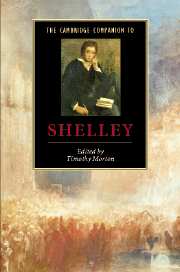5 - The storyteller
from Part II - Works
Published online by Cambridge University Press: 28 January 2007
Summary
Narrative experimentation
How, my dear Mary, are you critic-bitten
(For vipers kill, though dead) by some review,
That you condemn these verses I have written
Because they tell no story, false or true?
(The Witch of Atlas, 1–4; N)When he addressed these lines to his wife Mary in August 1820 in the dedication to The Witch of Atlas, Shelley's tongue was firmly in his cheek. Not only does the poem tell a story, it transforms a range of mythic motifs into a brilliantly playful fantasy on creative power and the life of the imagination so as to reflect on the art of storytelling itself. But the Witch is addressed to a cultivated literary intelligence, and Shelley knew that the close and informed attention it calls for not all readers would be willing or able to give. So his lines aim to disarm in advance the disappointment of those in search of what in the subtitle he calls 'human interest', embodied in a tale that plainly declares itself as either fiction or fact; such, he archly suggests, are the critics of the reviewing periodicals who up till then had mostly delivered disapproving or outraged opinions on his verse - when they had bothered to notice it at all.
Despite the gentle teasing and the mock-serious tone, Shelley is here touching on an important feature of his own work: the narrative experimentation that marks every phase of his career. If we set aside for the moment his prose fiction and drama, and fix a lower limit - inevitably somewhat arbitrary - of about sixty lines, we can calculate that in a writing life of barely fourteen years he produced some forty poems in which developed narrative is the dominant organizing principle.
- Type
- Chapter
- Information
- The Cambridge Companion to Shelley , pp. 85 - 103Publisher: Cambridge University PressPrint publication year: 2006
- 1
- Cited by

